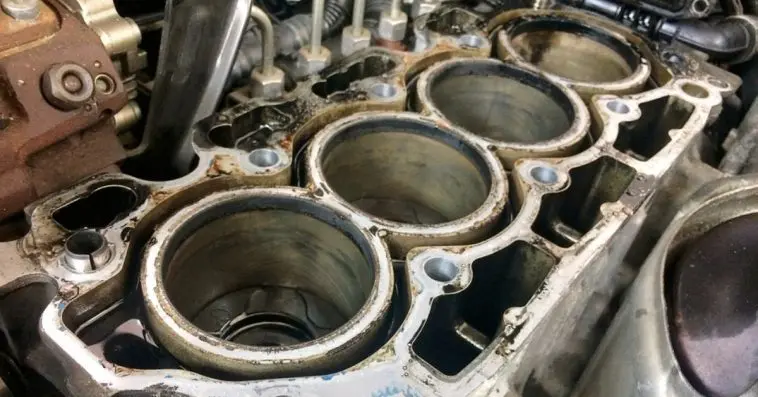Did you know that a head gasket is the most stressed seal in an engine?
In a well-maintained engine, it can last as long as the engine, but sometimes the building pressure can cause the gasket to blow up.
It doesn’t happen, but when it does, it is indeed serious. So, can you drive with a blown gasket?
No. Do not even attempt to drive. A blown head gasket is a major repair and one that is expensive on any car.
And as such, driving with it causes internal stress and damages the integrity of the engine. Drive only as an emergency if you have no way to get to your destination.
Lssues with the head gasket do not appear on one fine day; They start as cracks that widen when not maintained properly.
If you’ve identified a crack, all you need is a sealant, that costs you much less. Identify the leak, seal the crack and you are all set.
TABLE OF CONTENTS
What Happens If You Drive With A Blown Head Gasket?
The head gasket is part of the combustion chamber jammed in between the engine block and the cylinder head.
It keeps the fuel and the compressed air inside the cylinder where it ignites and turns into energy.
It also makes sure that the coolant and the oil are outside the combustion chamber so that they do not spoil the ignition.
The head gasket essentially creates a seal between the lower part of the engine and the upper part. It also works to channel the coolant to sustain the temperature of the engine when it is in action.
A blown head gasket allows the fluids and gases to mix and get into places where they should not be. The gases present in the combustion chamber can mix with the coolant and vice versa.
It can also let the oil into the chamber, which is not the right place for it to be. The danger is really when the liquids and gases are in the wrong places.
With the above in mind, another question I often get asked is, “How long can you drive on a blown head gasket?”.
The answer to this question is not simple. Is your head gasket leaking, or is it full on blown? If it is the former, you get time to seal it with a sealer like K-Seal.
However, when it blows, you cannot go far, and it is also dangerous to keep going.
Issues Caused
A blown head gasket can cause the engine to lose its pressure, and the pistons cannot power with the original force. An experienced driver can feel the loss of power instantly.
You may face one or both the problems mentioned here:
1. Allows Coolant To Escape The Engine
A blown gasket can cause the coolant to escape from the engine, which results in loss of the same. This leads to your engine overheating if you continue to drive.
The escaping coolant is really hot and can cause burns if you take it upon yourself to check under the hood. In the worst case, it can also start a fire.
2. Allows Coolant To Enter The Cylinder
When the coolant enters the cylinder, it mixes with the engine oil and the fuel. The result is a white smoke that you see coming out of the exhaust pipe of your vehicle.
When too much coolant mixes with the engine oil, it prevents the cylinders from being properly lubricated, leading to serious engine damage, including rusting.
You will have to rebuild your engine again if this happens. And here is the article of the cost of rebuilding your engine.
3. Allowing Engine Oil To Leak
When the engine oil leaks, the oil levels reduce, which in turn affects the lubrication. This harms the camshafts and also the bearings.
4. Allowing Gases To Leak
When gases leak out of the combustion chamber, they mix with the coolant and create an unusual pressure in the cooling system.
The gases and the leaking coolant create temperature variations which cause the area around the leak to erode and crack as the days go by.
Why Do Head Gaskets Blow?
To understand the reason why head gaskets, the part of the engine that is supposed to last forever, blows, you need to understand the role it plays.
As said earlier, it lies between the engine block and the cylinder, which means that it forms a seal to keep the hot combustion gases that are always under high pressure away from the coolant, which is anywhere from a cold temperature to room temperature.
Here are a few reasons why your head gasket might blow:
- Due to its varying temperature ranges and the surface area, cracks can form on the surface and develop into leaks. If these leaks are not identified in time, they can blow, leading to more serious issues.
- Head gaskets can also blow due to your engine overheating. When overheated, the metal part of the engine block expands to its maximum pressing against the head gasket, which at one point fails.
- Another important reason for a blown head gasket is engine pre-ignition, which happens when cylinders work out of time. This strains the pistons, valves, and the head gasket.
The only way to prevent a head gasket from blowing is to keep the engine in tune and in working order through regular maintenance. And to keep the coolant in the best working condition.
How Can You Identify If A Head Gasket Is Blown?
Since the head gasket is essentially a seal, you cannot see it visually when you open the hood.
You’d have to disassemble the engine to locate it, which makes it very difficult to see a blown one. It is important that you understand the symptoms to recognize a blown head gasket.
Engine Overheating
After your head gasket blows, your engine tends to overheat, especially on long drives. The main reason for this is the absence of coolant since it mixes with the engine oil and other fluids.
The combustion process generated so much heat that the little of the coolant present cannot handle it. And also due to the inability of the car’s radiator to cool the polluted coolant.
When your engine overheats, the metal components expand past its prime, which results in cracks. This can permanently damage the parts and create other leaks leading to an engine rebuild.
White Smoke From Tailpipe
After a head gasket leaks, the coolant seeps into the combustion chamber with every stroke.
It then burns along with the fuel during the process and creates a white smoke, which then comes out of the exhaust pipe.
Moisture from a cold start can also appear as white smoke, but this differs from a coolant burn by a sweet smell and continues even after the engine is warm and running.
When the head gasket blows, the white smoke can be large and surge from the tailpipe.
Leaking Coolant Externally
An external leak in the head gasket can cause the coolant to come from under the exhaust manifold. This happens only when the engine warms up fully.
In the case that there are no cooling hoses near the leak, you can identify it as from the head gasket.
If not, you might have to add a UV dye and watch it through the UV light to spot the leak.
Bubbles In The Coolant Reservoir
A leaky or blown head gasket allows the gases present in the combustion chamber to mix with the coolant.
The gases cause bubbles in the coolant reservoir, making it look as if the coolant is boiling, but the temperature is the same.
This is due to the gases which make this way into the reservoir looking for a way to escape.
You can identify the presence of gases using an Engine Combustion Leak Detector. This is by far the simplest and the most effective way of detecting a blown head gasket.
White Or Milky Oil
If the coolant seeps into the combustion chamber, it can mix with the oil causing it to turn to a milky white color. You can check for the same using your dipstick.
The presence of coolant in the oil reduces the lubrication, which in turn increases the friction causing the engine parts like the cylinder walls and the crank and camshaft to wear out easily.
Even if the engine is not running, the coolant in the oil can rust the surfaces resulting in pitting.
Reduced Cooling System
Another way to identify a blown head gasket is to pressurize the cooling system and watch for it to lose its pressure.
This pressure loss may be due to the head gasket or other leaks, which is the reason this test is not conclusive.
Similarly, performing a leak down test on the combustion chamber and measuring the gas leaking through the head gasket also gives you an indication of a blown head gasket.
Clogged Spark Plug
Yet another inconclusive way, but an indication of a blown head gasket is to watch out for white deposits on the spark plug. This article explains how to clean your clogged spark plugs.
Besides, there are more issues that cause the same, so you may have to watch out for more.
FAQs
Q1. Is It Worth Fixing A Blown Head Gasket?
You cannot simply ignore a blown head gasket and keep going. It will start an avalanche of issues, which will eventually lead to an engine rebuild.
When repaired on time, it doesn’t have to cost you much. But it also depends on the age and value of the car. It is up to you to decide whether to invest money on a blown head gasket or to total it.
Here’s the helpful article you can read about how to fix a blown head gasket without replacing it.
Q2. How Long Will My Car Last With A Blown Head Gasket?
The answer depends on the condition of your engine and how bad the leak is. Ideally, you can keep going for a month, but it is safer to get the gasket repaired or replaced before that.
After 30 days, an engine failure can occur, after which you may have to pay for serious repairs.
In the meantime, drive with the heat on high so that the heat from the engine is utilized to keep the car hot. This reduces the temperature in the engine block.
Q3. How Much Is A Head Gasket Repair Going To Cost Me?
A typical repair on a head gasket is going to cost you anywhere between $1000 to $2000, and this includes the labor and expertise.
This depends on the make and model of the car and also other factors including:
- Cylinder head
- Cylinder banks
- Damage to the engine
- Damage to the cylinder head
- Other replacements
The head gasket costs you around $100 and lesser than that. But the expense comes from the labor.
Another important influence on the expense is the engine block and cylinder repair. If they both are damaged, a replaced head gasket cannot do anything until these are also repaired.
For more details, you can go here to learn about it!
Conclusion
A head gasket does not blow out of the blue. It starts as a simple leak, which then proceeds to be a full-blown head gasket.
The leaks, when identified in the initial stage, can require just a sealant. In the later stages, it can cause the engine to fail, which can result in a rebuild.
And along with the rebuild, the expense also increases, leading to an expensive car repair, at which point you have to decide between continuing the repair or totaling the car.
Hence it is imperative to identify the leaks as early as possible.
In the meantime, it is not safe to drive around with a blown head gasket. It can cause a variety of problems starting with your engine overheating.
Since the head gasket is a seal, it lies deep inside and is not visually possible to see without having to dismantle the engine.
And for this reason, you need to educate yourselves on the symptoms of a leaky/blown head gasket.
From a white smoke from the tailpipe to an overheated engine, milky oil, and bubbles in the coolant reservoir, there are quite a few ways you can identify a leak.
Few of them conclusive, while others just an indication. The best option is to reach out to a professional.




